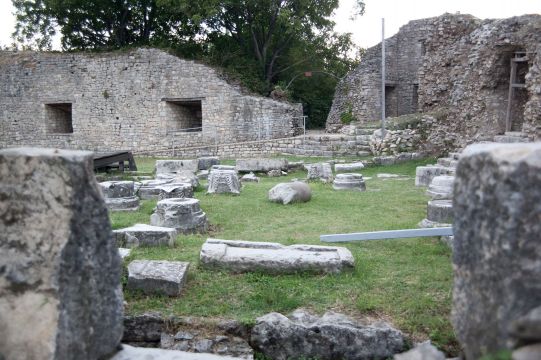Among the remains of the Solin buildings, of particular interest is the complex known as Gradina (Hill-Fort), next to the very river and the Roman town’s eastern walls. A church of an unusual ground plan, built over the Roman époque remains, is today situated within a medieval fortress. This was built, according to some authors (F. Bulić and Lj. Karaman), by the Split archbishop Ugolino de Mala Branca (1349-1388) to protect the people of Split from the people of Klis. Today, it is in a fortress built during the Venetian-Turkish wars, in the 16th century. It was researched in 1909-1911 and again in 1923-1925, its ground plan and volume have recently been presented in drawings by J. Marasović, which is a convincing reconstruction. The church was for the first time correctly dated to the time of the Byzantine emperor Justinian (527-567) by M. Prelog, some fifty years ago.
Accepting this as a correct attribution, we hold that the church was dedicated to the Virgin Mary who, as confirmed by documentary evidence, was celebrated in Salona in the beginning of the 6th century, and the church at Gradina is from exactly that period. In the 10th and the 11th centuries it was repaired and reconstructed, keeping its original dedication. The ancient tradition of the adoration of Virgin Mary in Salona-Solin is still preserved, and the tradition can be suggested to have been in the following sequence. When, namely, adoration of royal graves in St. Stephen’s Church at Our Lady's Isle was neglected and forgotten in later époques, the church at Gradina was abandoned and ruined, or the Ugolino’s fortification built around it, adoration of the Virgin Mary was moved to the islet. St. Stephen’s Church then became the Solin parish church. It is certain that the church at Gradina was not functioning by the 16th century.
Having in mind the old-Christian tradition of adoration of the Virgin Mary in Salona, the Virgin Mary’s sanctuary now known as Our Lady of the Islet (Gospa od Otoka) in Solin is undoubtedly the oldest church in Croatia. It is worth mentioning the tradition of trade fairs, along with religious celebrations, on the Mary’s Nativity Day in Solin since ancient times this was of great importance for the economy of a large area both along the coast and into the hinterlands which stretched all the way to Bosnia in the past. At the trade fairs, they exchanged products of town handicrafts and rural industries. Today, the trade fair has no such importance, yet it is an attractive local and religious tradition. The trade fair tradition in Solin was interrupted by the Venetian authorities several times, in 1743, for instance, because of the plague that appeared in the far away Sarajevo.









